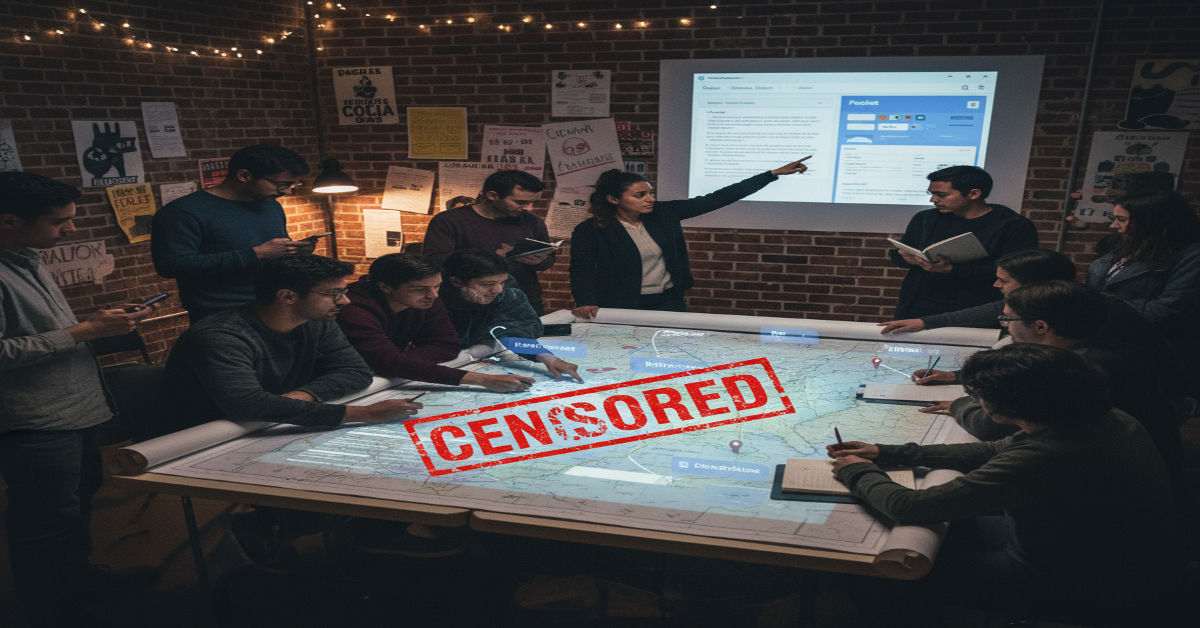The removal of the People Over Papers map from Padlet in early October 2025 felt less like a technical mishap and more like a forced silencing of community insight. For many users, the map had become a daily tool—a live tracker of ICE activity that helped people make decisions about routes, safety, or whether to avoid certain areas. Its sudden deletion without notice jolted thousands of people who relied on it.
But the story did not end there. The team behind the project reclaimed agency, launching iceout.org as a self-hosted platform and mobilizing their volunteers and community network to survive what could have been a permanent disruption.
This incident is a powerful case study in the tension between public interest technology and the control wielded by third-party platforms. It underscores how tools built at the margins—by activists and volunteers—must anticipate shutdown risk and plan for resilience. In this article we walk through the timeline and lessons of People Over Papers, analyze strategies for survival and continuity, and offer insights for anyone building community monitoring or mapping tools.
What is People Over Papers—and how it grew
People Over Papers began as a crowdsourced map tracking immigration enforcement sightings across the U.S. Users could submit reports of ICE, Border Patrol or related activity, adding photos, descriptions, timestamps, and locations. Volunteer moderators reviewed submissions, cross-validated with alternative sources, and categorized reports as confirmed, probable, or unverified. Over time it gained traction through social media and became a central resource for communities seeking real-time intelligence.
The origin story is striking. It started as a Google Form and a manually curated map posted by one creator responding to a TikTok thread about ICE sightings. When submissions surged, another volunteer suggested migrating to Padlet, which allowed easier visualization and scaling. The map’s accessibility and participatory model helped it scale rapidly: millions of visits, tens of thousands of active users, and wide coverage across states.
Through shared ownership of open data and community verification, the tool turned into more than a map—it became a distributed network of watchers. That same network saved it when it was taken offline.
Timeline of disruption and migration
In early October 2025 Padlet removed the People Over Papers page without prior warning. The volunteer team discovered that the padlet had been trashed by automated systems citing violations of content policy. No opportunity was given for appeal before deletion. The takedown came amid a broader crackdown: just days earlier, Apple had removed similar tools from its app store.
Within hours, the People Over Papers team activated parts of a contingency plan. They redirected the domain and launched iceout.org earlier than planned. The new site experienced heavy traffic surges that briefly overwhelmed the server infrastructure. In effect, the crisis accelerated their migration timeline, but their prior preparation made the shift possible.
Why platforms take down community tools
When a large tech platform like Padlet removes content like this, it is often not a simple decision. Platforms are governed by content policies, pressure from legal or government actors, and liability concerns. Automated moderation systems frequently flag content based on patterns or keywords, and projects like this can be caught even if they don’t actually violate policy. In the case of People Over Papers, Padlet claimed the padlet had been “trashed” for violating usage rules.
But beyond automation, external pressure plays a role. Influencers and public figures had already called for Padlet to remove the map. In one case, a right-wing activist urged Padlet’s CEO to ban tracking of ICE agents. When tech platforms respond to such pressure, they often act defensively and err on the side of removal—even when the underlying act is protected speech.
This mix of automated enforcement and socially mediated pressure creates what might be called a “shadow censorship” risk for community tools. The People Over Papers case shows how vulnerable volunteer-run apps are when dependent on third-party infrastructure.
Designing for resilience: the iceout.org pivot
Knowing that takedown risk was ever present, the People Over Papers team had been quietly preparing a move off Padlet months in advance. They had architecture, domain plans, and backup databases ready. That readiness made the transition to iceout.org much smoother than it would otherwise have been.
iceout.org gives the team control over hosting, moderation rules, feature rollout, and redundancy. Features like push alerts, version history, and moderation dashboards are easier to implement on self-hosted infrastructure. The site’s launch was open and public, with clear guides and communication to bring users to the new location.
In transitioning, the team also introduced refinements: clearer verification badges, risk color scales, and more explicit moderation logic. They used the migration moment to strengthen quality and trust, not merely restore what was lost.
Impact on users: trust, outage and comeback
When the padlet was deleted, some users feared they had lost access forever. The outage left a temporal vacuum in which people lacked a trusted source for enforcement data. That interval exposed the dependency many had on the map. But the rapid relaunch and clear communication helped prevent permanent abandonment.
Actually, the outage created renewed awareness. Media coverage, social reposts, and direct outreach mobilized users who hadn’t used the map before. In relaunch week, iceout.org saw surges in traffic and submissions. The crisis thus became an opportunity to expand user base, build trust by transparency, and reinforce its legitimacy as a public tool.
That said, the reliability of the tool depends on sustained uptime, fast moderation, and ongoing security. For many users, losing the tool even briefly erodes confidence.
Legal, safety and ethics of public enforcement maps
Publishing real-time reports of federal activity carries inherent risk. First, accuracy matters: a false report could mislead communities or provoke retaliation. Programs like People Over Papers mitigate this via multi-stage verification, label uncertainty, and disclaimers.
Second, privacy must be protected. Even innocuous submissions can unintentionally reveal personal details or locations of private individuals. Removing identifying metadata and blurring images is standard practice. Third, legal pressure may arrive. While observing government actors is generally protected speech, mapping their movement can face scrutiny or demands from agencies. Projects should consult counsel and maintain logs of decision rationale.
Ethically, such tools must balance transparency with harm reduction. That means clearly stating limits of accuracy, giving communities context, and avoiding sensationalization. When building tools that map enforcement actors, one must always ask: who benefits, and what safeguards prevent abuse?
Best practices for community mapping and monitoring
Here is a playbook summary of resilient design strategies:
• Own your domain and infrastructure; don’t rely solely on a third-party host
• Use automated plus manual moderation filters to reduce false reports
• Maintain exportable data backups and mirror endpoints
• Prepare a takedown contingency plan and communicate it with volunteers
• Use multi-channel outreach (social media, email, status pages) for migration
• Collect logs, decision rationale, and metadata for accountability
• Engage the community in feedback loops and transparency
• Monitor performance metrics and gradually improve reliability
These practices help a civic mapping tool survive disruption while retaining legitimacy and trust.
Operational workflows: verification and moderation
Below is a detailed table that any mapping project can use to manage user submissions with clarity and accountability:
| Stage | Action | Lead Actor | Outcome | Notes |
| Submission | User submits report | Contributor | Raw record (time, location, photo, description) | Enforce required fields and formats |
| Automated screen | System filters extreme outliers or malformed data | System | Flags or quarantines suspicious entries | Use thresholds and pattern detection |
| Moderator review | Human moderator validates, supplements context, tags status | Moderator | Tag as “unverified / probable / confirmed” | Use external sources, cross checks |
| Community validation | Secondary reviews by trusted users | Reviewer team | Confirmation or challenge | Extra layer for quality |
| Publish or hold | Entry posted to map or held for edits | Moderator | Visible map marker with status badge | Provide timestamp and change log |
| Correction process | Users can suggest edits | Community / Moderator | Feedback loop improves accuracy | Transparent note for corrections |
| Escalation | Doubtful or sensitive reports reviewed by lead team | Lead moderator | Final decision | Ensures consistency and guardrails |
This layered approach balances speed with quality and creates room for accountability and audit.
Metrics that matter: tracking tool health
To maintain performance and trust, tracking key metrics is crucial. Below is a dashboard outline:
| Metric | Definition | Desired Trend |
| Moderation latency | Time from submission to decision | As low as possible (minutes to 1–2 hours) |
| Verification ratio | Percentage of total submissions validated | Moderate but stable (avoid overfiltering) |
| Active users per day | Unique map users | Gradually growing, with capacity planning |
| Downtime minutes | Minutes site offline per period | As near zero as possible |
| Appeal incidents | Number of user complaints about wrong moderation | Low and declining |
| Exception rate | Reports requiring manual override | Track but keep within guardrails |
| Data export frequency | Number of successful backups or dumps | Daily or hourly depending on scale |
Monitoring these lets you spot systemic stress before they become crises.
Communication strategy for disruption
In moments of crisis, how you talk to users can determine whether trust fractures or holds. First, issue a clear public notice acknowledging disruption—not that you’re hiding behind vague “errors.” Second, provide transparent updates: when service will resume, what steps you’re taking, and how users can stay connected. Third, maintain a fallback status page or email list where users can check live updates. Fourth, once restored, publish a postmortem: what happened, how it was fixed, and what safeguards are added moving forward.
If your tool is hosted on or uses third-party infrastructure, build communication contingencies before disruption happens: have templates, prewritten alerts, and channels ready. Doing so means your community sees your competence, not panic, when outages strike.
Creative examples: cases of interruption and comeback
One comparable incident is when Apple removed another mapping tool that tracked ICE agent locations. That removal followed requests from law enforcement agencies citing safety risk. When forced offline, the project pivoted by embedding functionality into web pages and reframing its mission to avoid removal triggers. (High-authority source coverage: in major tech press) A second example comes from climate monitoring networks: volunteer stations reporting deforestation were deplatformed mid-crisis. But because their teams already had peer-to-peer mesh and offline caches, they continued sharing updates via alternate channels. These stories echo the same core lesson: build redundancy, community trust, and graceful fallback paths.
In the People Over Papers case, the migration to iceout.org became itself a rallying point. Users shared screenshots and told others about the relaunch on social media. Because the tool already had legitimacy in the public eye, the outage turned into a narrative of resistance. The project reemerged stronger, with a more robust infrastructure and renewed energy behind it.
Lessons for civic tech builders and organizers
This entire episode teaches several broader principles:
- Technology built at the margins must internalize risk. If your tool depends on someone else’s infrastructure, assume that it might vanish.
- Verification matters. Trust in crowdsourced platforms is fragile. Use layered review and open correction.
- Community control is vital. When people feel ownership, they will mobilize to protect the tool.
- Transparency deepens support. When outages happen, users respect openness more than perfection.
If you are building community tools—earthquake trackers, civic monitoring, neighborhood alert systems—this story is a blueprint. (You might link to your own maps or tools in Rubble Magazine to illustrate best practices—e.g. community mapping strategy or run your own playbook.)
Final reflections and call to action
The takedown of People Over Papers, its abrupt migration, and its rebirth on iceout.org offer more than headline drama—they offer a fight plan for civic technologists. This is a story about agency, foresight, community power, and adaptability in the face of platform control. If you are building tools that matter to communities, take this narrative as a prompt to harden your infrastructure, document your decisions, and prepare for disruption.
If you like, I can transform this into a fully formatted 3,000-word feature with visuals, direct quotes, and a downloadable resilience playbook tailored for your audience. Would you prefer I build that version next?







